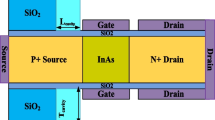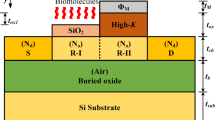Abstract
This study introduces and simulates a Gate-All-Around Nanowire Tunnel Field Effect Transistor (GAA-NW-TFET) biosensor for biomolecule detection. The proposed silicon-based device employs a cluster of charge probes to identify the target biomolecule. The biomolecules, modeled as charged particles within the electrolyte layer positioned on top of the insulating layer, constitute the focus of our investigation. The central aspect of our study involves evaluating how the spatial arrangement of these target biomolecules affects the biosensor's sensitivity. Our analysis is conducted using Silvaco ATLAS TCAD. The simulation result shows an impressive Ion/Ioff sensitivity factor of up to 2.95 × 1010 for the GAA-NW-TFET structure, equipped with a 10-probe array. This notable sensitivity factor indicates the biosensor's capability to detect the target biomolecule precisely. Moreover, our methodology considers the non-uniform distribution of ionic charges at the interface between the electrolyte and the insulator to improve the sensitivity assessment. Additionally, we explored the influence of the electrolyte's pH on the biosensor's sensitivity, considering the practical importance of pH variations in real-world scenarios.
Similar content being viewed by others
Data Availability
The data and materials that have been used in this work is provided upon reasonable request.
References
Ghomi A, Shalchian M (2022) Design-Oriented Physical Model of Ion-Sensitive Field Effect Transistor for pH Sensing. IEEE Sens J 23(3):2354–2363
Bergveld P (2003) Thirty years of ISFETOLOGY: What happened in the past 30 years and what may happen in the next 30 years. Sens Actuators B Chem 88(1):1–20
Gandhi R, Chen Z, Singh N, Banerjee K, Lee S (2011) CMOS-Compatible Vertical-Silicon-Nanowire Gate-All-Around p-Type Tunneling FETs With ≤ 50-mV/decade Subthreshold Swing. IEEE Electron Device Lett 32(11):1504–1506
Reddy NN, Panda DK (2021) A comprehensive review on tunnel field-effect transistor (TFET) based biosensors: recent advances and future prospects on device structure and sensitivity. SILICON 13(9):3085–3100
Narang R, Reddy KS, Saxena M, Gupta R, Gupta M (2012) A dielectric-modulated tunnel-FET-based biosensor for label-free detection: Analytical modeling study and sensitivity analysis. IEEE Trans Electron Devices 59(10):2809–2817
Devi WV, Bhowmick B, Pukhrambam PD (2020) N+ pocket-doped vertical TFET for enhanced sensitivity in biosensing applications: modeling and simulation. IEEE Trans Electron Devices 67(5):2133–2139
Chong C, Liu H, Wang S, Chen S (2021) Simulation and performance analysis of dielectric modulated dual source trench gate TFET biosensor. Nanoscale Res Lett 16:1–9
Narang R, Saxena M, Gupta M (2015) Comparative analysis of dielectric-modulated FET and TFET-based biosensor. IEEE Trans Nanotechnol 14(3):427–435
Goswami R, Bhowmick B (2019) Comparative analyses of circular gate TFET and heterojunction TFET for dielectric-modulated label-free biosensing. IEEE Sens J 19(21):9600–9609
Saha P, Sarkar SK (2021) Drain current characterization of dielectric modulated split gate TFET for bio-sensing application. Mater Sci Semicond Process 124:105598
Verma M, Tirkey S, Yadav S, Sharma D, Yadav DS (2017) Performance assessment of a novel vertical dielectrically modulated TFET-based biosensor. IEEE Trans Electron Devices 64(9):3841–3848
Wadhwa G, Raj B (2018) Parametric variation analysis of symmetric double gate charge plasma JLTFET for biosensor application. IEEE Sens J 18(15):6070–6077
Anand S, Singh A, Amin SI, Thool AS (2019) Design and performance analysis of dielectrically modulated do**-less tunnel FET-based label free biosensor. IEEE Sens J 19(12):4369–4374
Bhattacharyya A, De D, Chanda M (2022) Sensitivity measurement for bio-TFET considering repulsive steric effects with better accuracy. IEEE Trans Nanotechnol 21:100–109
Wang Y, Li C, Li O, Cheng S, Liu W, You H (2022) Simulation study of dual metal-gate inverted T-shaped TFET for label-free biosensing. IEEE Sens J 22(19):18266–18272
Bhattacharyya A, Chanda M, De D (2019) Performance assessment of new dual-pocket vertical heterostructure tunnel FET-based biosensor considering steric hindrance issue. IEEE Trans Electron Devices 66(9):3988–3993
Shafi N, Bhat AM, Parmar JS, Sahu C, Periasamy C (2021) Analytical modeling of surface potential and figure of merit computation for planar junctionless pH sensing BioFET. IEEE Trans Nanotechnol 20:534–542
Passeri D, Morozzi A, Kanxheri K, Scorzoni A (2015) Numerical simulation of ISFET structures for biosensing devices with TCAD tools. Biomed Eng Online 14:1–16
Chung I-Y, Jang H, Lee J, Moon H, Seo SM, Kim DH (2012) Simulation study on discrete charge effects of SiNW biosensors according to bound target position using a 3D TCAD simulator. Nanotechnology 23(6):065202
Tomizaki KY, Usui K, Mihara H (2005) Protein-detecting microarrays: current accomplishments and requirements. ChemBioChem 6(5):782–799
Hom NM, Promptmas C, Wat-Aksorn K (2015) Detection of DNA hybridization using protein A modified ion sensitive field effect transistor. Anal Lett 48(7):1128–1138
Shafizade D, Shalchian M, Jazaeri F (2021) Charge-based modeling of ultra narrow junctionless cylindrical nanowire FETs. Solid-State Electron 185:108153
Shafizade D, Shalchian M, Jazaeri F (2019) Ultrathin junctionless nanowire FET model, including 2-D quantum confinements. IEEE Trans Electron Devices 66(9):4101–4106
Gautam VK (2017) Dynamically controlled DNA tiles: looking beyond the self-assembly of static two-dimensional DNA-based computational structures. Doctoral Thesis, Norwegian University of Science and Technology
Chen Z et al (2009) Demonstration of tunneling FETs based on highly scalable vertical silicon nanowires. IEEE Electron Device Lett 30(7):754–756
Pandey CK, Dash D, Chaudhury S (2018) Impact of dielectric pocket on analog and high-frequency performances of cylindrical gate-all-around tunnel FETs. ECS J Solid State Sci Technol 7(5):N59
Duan X, Li Y, Rajan NK, Routenberg DA, Modis Y, Reed MA (2012) Quantification of the affinities and kinetics of protein interactions using silicon nanowire biosensors. Nat Nanotechnol 7(6):401–407
Sciuto EL et al (2018) Functionalization of bulk SiO2 surface with biomolecules for sensing applications: Structural and functional characterizations. Chemosensors 6(4):59
Mohammadi E, Manavizadeh N (2018) An accurate TCAD-based model for ISFET simulation. IEEE Trans Electron Devices 65(9):3950–3956
Bandiziol A, Palestri P, Pittino F, Esseni D, Selmi L (2015) A TCAD-based methodology to model the site-binding charge at ISFET/electrolyte interfaces. IEEE Trans Electron Devices 62(10):3379–3386
Dinar AM, Zain AM, Salehuddin F, Attiah ML, Abdulhameed M (2019) Modeling and simulation of electrolyte pH change in conventional ISFET using commercial Silvaco TCAD. IOP Conf Ser Mater Sci Eng 518(4):042020 (IOP Publishing)
A. U. s. Manual (2010) Device simulation software, Version 5.16. 3, R, Silvaco Int., Santa Clara, CA
Demirkiran N, Ekinci E, Asiltürk M (2012) Immobilization of glucose oxidase in silica sol-gel film for application to biosensor and amperometric determination of glucose. J Chil Chem Soc 57(4):1136–1339
Chey CO, Ibupoto ZH, Khun K, Nur O, Willander M (2012) Indirect determination of mercury ion by inhibition of a glucose biosensor based on ZnO nanorods. Sensors 12(11):15063–15077
Acknowledgements
The authors would like to express their gratitude to the Department of Electrical Engineering, Amirkabir University of Technology, Tehran, Iran for providing access of the facilities.
Author information
Authors and Affiliations
Contributions
Andisheh Ghomi and Majid Shalchian jointly conceived the idea, developed the theoretical framework, conducted the computational analysis, discussed the results, and made significant contributions to the final manuscript. All named authors have read and approved the manuscript, and there are no additional individuals who meet the criteria for authorship but are not listed. The order of authors in the manuscript has been agreed upon and approved by all of us.
Corresponding author
Ethics declarations
Ethical Approval
Authors approve that the submitted work is original and has not been published elsewhere in any form or language (partially or in full).
Consent for Publication
Not applicable.
Competing Interests
The authors declare no competing interests.
Additional information
Publisher's Note
Springer Nature remains neutral with regard to jurisdictional claims in published maps and institutional affiliations.
Rights and permissions
Springer Nature or its licensor (e.g. a society or other partner) holds exclusive rights to this article under a publishing agreement with the author(s) or other rightsholder(s); author self-archiving of the accepted manuscript version of this article is solely governed by the terms of such publishing agreement and applicable law.
About this article
Cite this article
Ghomi, A., Shalchian, M. Simulation of GAA-NW-TFET Biosensor with Cluster Charge Probes for Target Biomolecule Detection. Silicon 16, 397–405 (2024). https://doi.org/10.1007/s12633-023-02676-0
Received:
Accepted:
Published:
Issue Date:
DOI: https://doi.org/10.1007/s12633-023-02676-0




